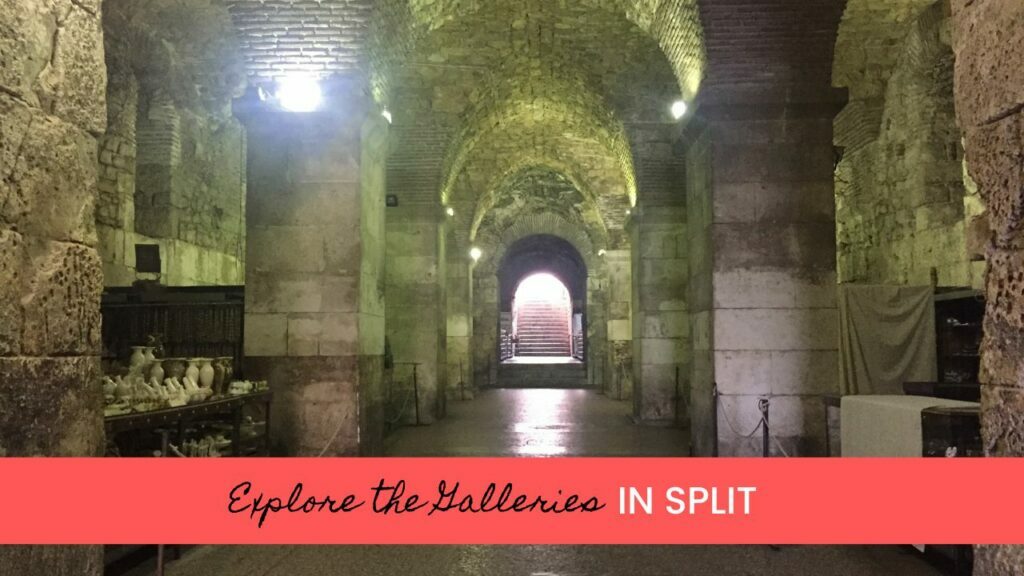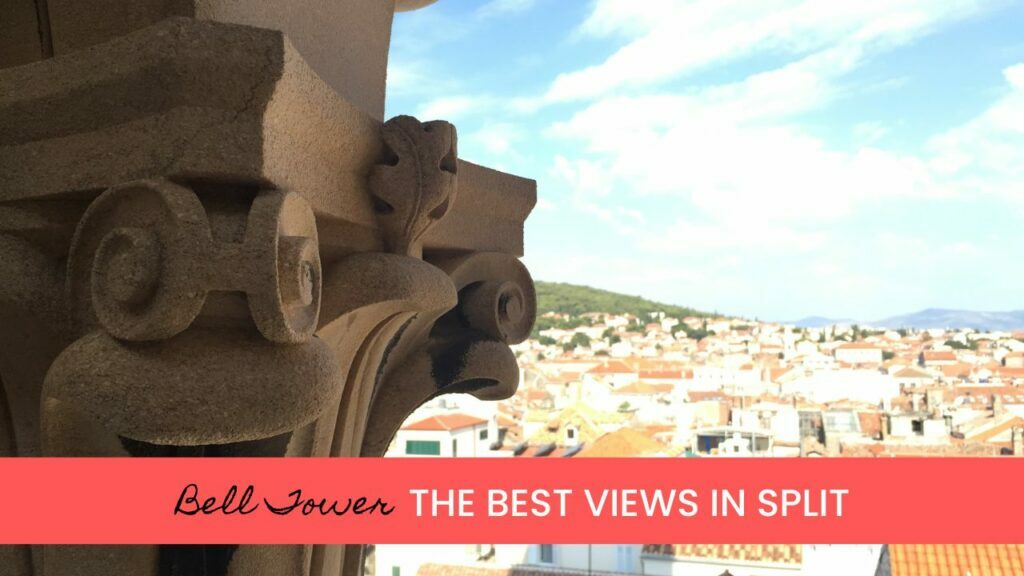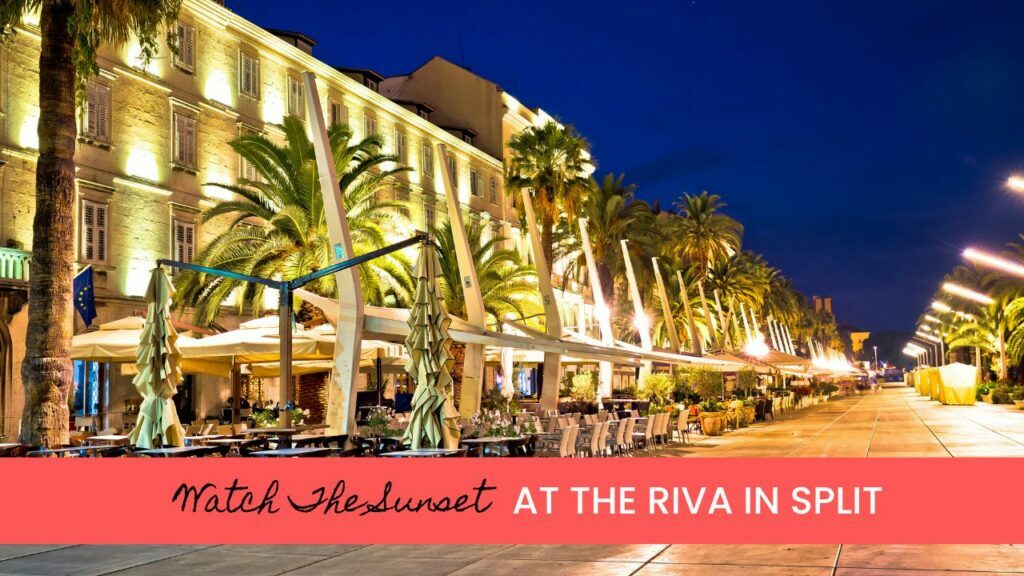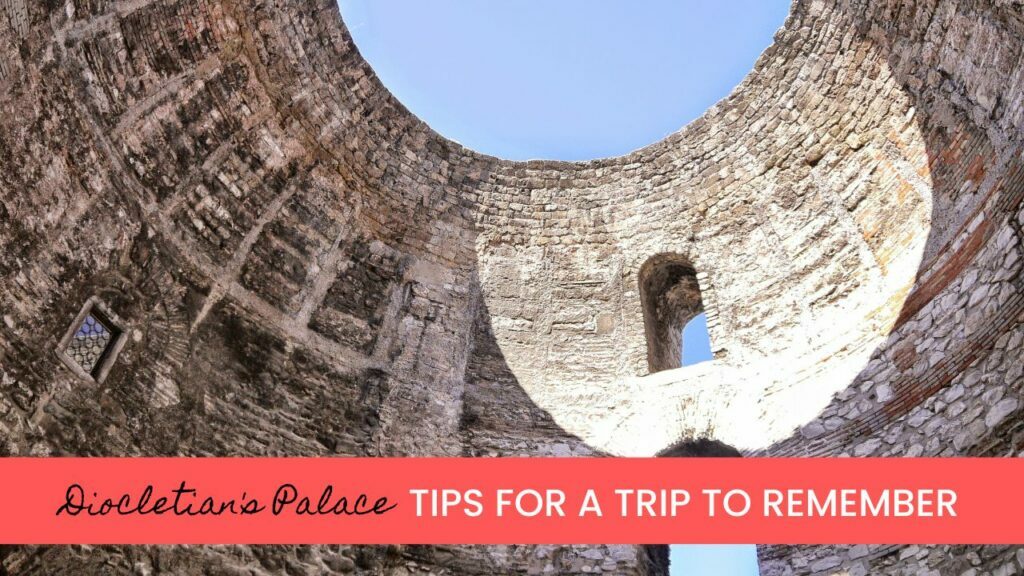Why you should visit Diocletian's Palace
Split’s main attraction is Diocletian’s Palace…although many people who visit it don’t realize that they are in the palace. This is because the palace is the old city. This was Diocletian’s favorite vacay spot, so when he gave up the throne of the Roman Empire (voluntarily), he decided to settle in Split and build the most amazing beach house anyone had ever seen. I’ve now visited Split a few times and I am going to share tips to make your visit to Diocletian’s Palace in split a time to remember well.
Tips for Your Diocletian's Palace Visit
Buy tickets in advance:
Procrastinate at work, but don’t be a snooze hitting procrastinator! Avoid the long lines by getting to Diocletian’s Palace early. You can walk the city for free, but if you want to see inside the buildings you will have to pay. Trust us, you’ll thank us later.
Wander the Galleries Downstairs,

Don’t be afraid to venture underground at Diocletian’s Palace. The tunnels may not be glamorous, but they’re an essential part of the palace’s history and offer a unique perspective.
The underground galleries, which are located beneath the palace, were originally used as storage and utility rooms (and to hold prisoners). Today, they have been converted into a series of small shops, cafes, and restaurants.
The underground galleries offer a unique shopping experience, as they are located in an ancient, atmospheric setting. Visitors can browse a variety of souvenirs and local handicrafts, such as jewelry, ceramics, and textiles. There are also a number of artisanal food stalls, offering local specialties such as olive oil, honey, and spices.
In addition to this, the underground galleries also offer a number of dining options and shops. There are a number of small cafes and restaurants offering traditional Croatian cuisine, as well as international options. The underground galleries are a popular spot for tourists and locals alike, and they offer a unique and memorable experience for visitors to Split
Get a View

Don’t skip the bell tower of Diocletian’s Palace!
The views of Split and the Adriatic Sea are breathtaking, and you won’t want to miss out on all that beauty.
The bell tower of Saint Domnius Cathedral is located right smack in the heart of the city, and it’s actually the oldest Catholic cathedral in the world. The bell tower is a really iconic symbol of the city.
You are allowed to climb and let me tell you all those stairs are worth it. The tower has really stunning views of Split and the surrounding area. You can see the whole city, as well as the Adriatic Sea and the surrounding islands, from the top of the tower. And the views are especially beautiful at sunset, when the city is all bathed in this warm, golden light.
PRO TIP: Get the combined ticket which lets you see the church, bell tower, crypt, treasury, and Baptistery.
Wear comfortable shoes
Drink Plenty of Water
Watch the Sunset on the Riva

It’s this really cool promenade along the harbor. It’s got tons of cafes, restaurants, and bars, so it’s a great spot to relax and take in the views of the Adriatic Sea. I love people-watching there too, because it’s always so lively and busy.
It’s close to a lot of the city’s top attractions and easy to find. You can check out Diocletian’s Palace, the Marjan Hill Park, and the Split City Museum all within a short walk. And the Old Town is just a short stroll away too – it’s got so many historic sites and landmarks to check out.
The Riva also hosts lots of events and festivals throughout the year. It’s a really popular spot for locals to gather and celebrate, so it’s a great place to get a taste of Split’s culture and traditions.
Overall, I think the Riva is a must-see destination if you’re visiting Split. Whether you want to relax with a drink, enjoy a meal, or just take in the sights and sounds of the city, the Riva has something for everyone.
The palace itself was made up of both living quarters, and defensive areas to protect the retired Emperor. His quarters were on the side facing the water, and could be entered by him via boat. This area is now the riva where locals and tourists alike enjoy coffee, gelato and some of the best people watching in Croatia.
How did Diocletian's Palace come to become a city for the masses?
Portus Aerelius in Ancient Days
The Northern Gate, or Golden Gate, was the main entrance to the Palace in the 4th century A.D. The most glorious of all the four entrances, It was large enough to admit a horse drawn carriage. Tight controls at this entrance were on twin, octagonal shaped towers on either side of its entrance.
The Tetrarcy
Four large pedastals remain to this day. Historians believed that displayed here were statues of the four rulers of the Roman Empire at that time – known as the tetrarcy. It consisted of the Diocletian who was born outside of Split in the suburbs of Salona, a major cosmopolitan town in the 3th century A.D. His co ruler, Maksimijan, a fellow Illiran general, ruled the western half of the empire while he spend most of his time in the east, at Nicomedia.
Nine years later, in 293 A.D., The two “vice presidential” caesars of the Empire joined them – Galerija (“the Barbarian”), who married the Diocletian’s daughter, Valerija – and Konstantin Klor (or Paleface), who divorced his then wife St. Helena to marry Maksimijan’s stepdaughter, Theodora. These were political marriages, of course, but all within the time. The golden door was the link between the Palace and Salona.
Grgur Ninski – famous Croatian
This massive statue was made in 1929 by Ivan Mestrović. Grgo Ninski was a 10th century bishop who stood up to the pope insisting that Croatian language be used to promote prosperity and education among the people. Ostracized, he prevailed.
This massive statue was made in 1929 by Ivan Mestrović. Grgo Ninski was a 10th century bishop who stood up to the pope insisting that Croatian language be used to promote prosperity and education among the people. Ostracized, he prevailed.
Source: by Silverije, CC-SA-3.0 unported, via Wikimedia Commons
The massive sculptor is the work of Ivan Meštrović. There are only 3 original Grgur Ninski’s in the world. People like to touch his big toe and make a wish
The massive sculptor is the work of Ivan Meštrović. There are only 3 original Grgur Ninski’s in the world. People like to touch his big toe and make a wish
Source: http://wikpedia
Outside the Walls of the Golden Gate
Right outside the walls themselves is a large imposing statue with his finger pointing upwards. This is the symbol of Croatia’s victory over the use of its ancient and very sophisticated alphabet called Glagolith alphabet. Grgo Ninski, or Gregory of Nin (a city to the north) was a very important Croatian Bishop fighting for the rights of Croatians to use their alphabet in the mass. Croatians are very tied to the (Western) Roman Catholic religion, if not literally then symbolically. The entire Balkan peninsula is of Eastern, or Orthodox belief system. Grgo Ninski was important because it helped Croatia develop its own identity, sandwiched between the latin (that no one knew or used) and the Eastern church. This statue is a great place to take a photo. Legend has it, if you touch the statue’s big toe and make a wish, it will come true.
The sculptor of this statue is Ivan Mestrovic. His works can be found in Montenegro, Serbia, Ireland, the United States (in New York and in Chicago) as well as in various locations within Croatia. Originally situated at the Peristil, Grgo Ninski, largely due to his massiveness, was relocated to the Northern Gate.
Inside the Walls of the Golden Gate
Between the inner and outer doors of the Northern wall was an inner area, the size of a large room. This was the point of last defense. From above are two hallways, one on the outer wall and another on the inner wall. From this vantage point, Palace guards would shoot down arrows at the enemy invaders, horses and warriors thrashing in confusion. They also used hot oil as a measure of self-defense. The Palace structure was very well designed and as far as historians know, was never broached or invaded in its 1700 year history.
Guard Fortifications
The guards lived within the city walls. There was a space between the inner and outer walls. In Romanesque times (after the Diocletian up to around the 10th century A.D.) some of the guard fortifications on the walls were converted to St. Martin’s church.
The interesting ancient architecture of the “pregrade” shows the border line where the holy and the unholy meet. A similar type facade was used in the Peristil at the pagan ceremonial area between the holy and the unholy. The design on the rock shows the simple but intricate style of the period.
Patron Saint of the Military
St Martin of Tours was born in Patagonia, near today’s Slovenia. Known for his military career, he later became a priest, then bishop. A tiny church is built into the former guard station walls with a 10th century altar.
St Martin of Tours was born in Patagonia, near today’s Slovenia. Known for his military career, he later became a priest, then bishop. A tiny church is built into the former guard station walls with a 10th century altar.
Source: Public Domain, Author unknown – over 70 years old, via Wikipedia
Saint Martin, Patron Saint of the Golden Gate
Saint Martin, not unlike Saint Theodor on the Western Gate, was a protector of the Military. These saints names and assignments were given during the Middle Ages when risk of invasion was the greatest with the constant attack of the Ottoman Empire all along the Dalmatian coast.
Saint Martin may have been the first Christian saint who was not tortured. During the Diocletian’s purges in the 4th century, the majority of Christian saints underwent terrible hardships. Martin was inducted into the army as a young teenaged boy. He was probably born in 316 in Panonia, located near Slovenia and Hungary. As a young teenaged boy, he went with his father in the military, later serving in France. After his conversion to Christianity, he left the army and later became the bishop of Tours. He is best known for sharing his cloak with a barely clad beggar on a cold winter night. This was in a dream but it was his best known legend. Very well known and loved, his following almost became a cult. He is the patron saint of the military throughout all of Europe.
Ancient Map of the Palace
This drawing made in 1911 shows how the Diocletian’s Palace probably looked in Ancient times. There are two major streets dividing the Palace into four distinctive blocks. The military was in the northwest block, the clothing factory the northeast.
This drawing made in 1911 shows how the Diocletian’s Palace probably looked in Ancient times. There are two major streets dividing the Palace into four distinctive blocks. The military was in the northwest block, the clothing factory the northeast.
Each gate was guarded by octagonal towers. The Diocletian was a superstitious, mystical type of retired military man, and the number eight served his sense of “eternal life”. In a way he got his wish, since his Palace is the last great example of Late Ancient Architecture anywhere in the world, and his name has been remembered for centuries.
Two streets – Cardo from the North-South direction, and Decumanus in the East-West direction. The entire palace was made mainly of white limestone from the island of Brac and marbled pillars from Greece and Egypt (after all he was the emperor, so what he saw and liked, he brought back home).
It was constructed from 295-204 – a period of approximately ten years. The cement is better quality than in modern times, and many historians speculate that it may be fortified with horses’ hair, blood, or eggs to add to its extremely adhesive and long lasting properties.
Elegance and Beauty
A famous fountain of aqueduct pumped water from the mountains outside of Split. This section is called the Get, a shortened name for Ghetto where working class people worked and lived.
A famous fountain of aqueduct pumped water from the mountains outside of Split. This section is called the Get, a shortened name for Ghetto where working class people worked and lived.
The Northern Section of the Palace
Two Main Streets – Four Blocks within the Palace
In the Diocletian’s day, there was a clothing factory used to make the Diocletian’s wonderful royal robes, located in the North – eastern Section. The water from the aqueduct was used in processing the fabric. The yellow plant, broom brush or aspalatos, was also used to make a deep reddish colored dye.
In the Northwestern section was military quarter – they lived here in the Palace, separate from ordinary civilians. The majority of civilians lived in the town of Salona, which was linked by a road leading north from the Golden Gate. It has 12,000 citizens, an arena, ampitheater, many churches and basilicas, graves and necropolis and a fantastic city-like infrastructure. They lived as well or better than people live today. The Diocletian’s waterways brought water from the mountains, to Salona, and on to the Palace area at the rate of 1,100,000 m3 which was enough water to support 170,000 people, far more than necessary.
In the northern section of the Palace, you will also find the amazing City Museum of Split at the Papalić Palace, built by the Papalić family in Split during the Renaissance times. This four story building with the huge Gothic shaped windows and views contains artifacts from Split’s long and interesting history. Perhaps the most interesting object inside is the Diocletian’s own serving platter which was discovered in the Palace’s substructure in a few large pieces.


